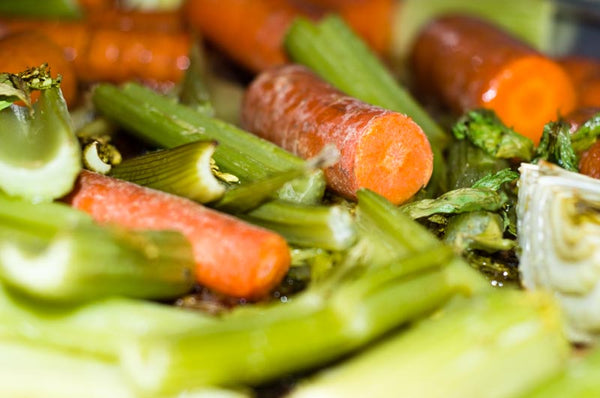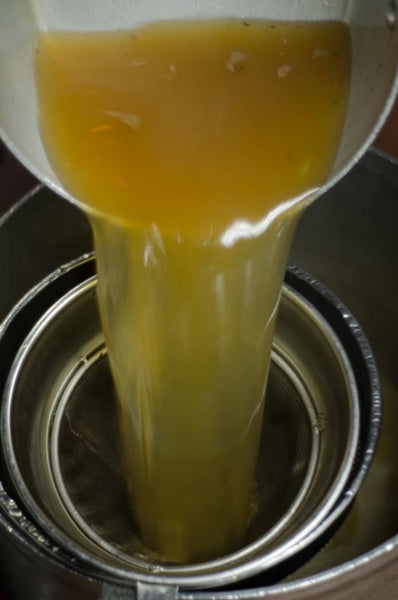- Continue Shopping
- Your Cart is Empty
How to make bone broth.
Bone Broth – Time’s best kept secret to optimal health
Encouraged by the response to our first bone broth post, we sought out an expert to teach us more about this fantastic food. This is a guest post by bone broth expert Ryan Harvey. Ryan eats, breathes and (of course) drinks this stuff, check out his fantastic bone broth business and learn more about him via the link at the end of this article.

What if you were let in on one of time’s best secrets to optimal health? An easy-to-make, extremely versatile food that would prevent disease and sickness, provide immediate energy, and give you longevity through strong bones and a healthy digestive system?
I’ll give you hint: It’s made from the bones, joints and feet of animals and is most commonly referred to as “bone broth” or “stock.”
Want this as a 1 page PDF recipe? Pick it up for FREE on our Store, here.
What is it?
You will find plenty of exhausting explanations highlighting the minutia in difference between these two terms. A broth is simply a seasoned stock, whereas a stock is an unseasoned base. So, a stock can be a broth but a broth cannot be a stock. Either way, they are both made from the bones, joints and feet of animals and offer a plethora of health benefits to us humans. So without further ado, let’s get into the good stuff!
Bone broths have been used in the diets of cultures around the world for centuries as a source of nourishment and healing. They can still be found in kitchens around the globe today as a base for everything from soups to sauces and stews to braising. They are sipped like tea or used to cook rice, millet and other grains. Stocks are the base of all cooking, making them the most versatile ingredient in your kitchen.
But because it’s time-consuming to make stocks and broths, and we are obsessed with convenience and urgency – they disappeared from the modern kitchen. They only resurfaced recently as a source of healing and nourishment in communities that recognize proper nutrition can heal many ailments from the inside out.
But why?
By simmering the bones, joints and feet of healthy, pasture-raised animals in water with herbs and vegetables for multiple days, you are basically making a flavorful extract of collagen, bone, skin, marrow and fat – the very essence of our being.
When we consume broth, these nutrients are in their most bio-available form and our bodies can absorb and put them to use immediately. The gelatin contained in it is a protein and hydrophilic colloid - meaning it attracts liquids and aids in digestion by pulling digestive juices into your food as it makes its way through your GI tract.
Your digestive system needs all the help it can get breaking down foods for your body to use as building blocks, because it’s under constant assault by the Standard American Diet (SAD). There’s supposed to be a delicate balance of healthy bacteria in our guts, but the SAD, unfortunately, contributes to an imbalance in those bacteria. It often even builds up an army of bad bacteria.
Commercially-made broths and stocks are made very rapidly with a focus on flavor and profit, and they contain very little gelatin and few nutrients, if any at all.
Don’t lose hope, though, it’s easy and fairly inexpensive to make at home.
Because I already eat, sleep and breathe broth, I’d like to share some tips that will help you make it at home. I prefer not to teach using a recipe, but rather using a framework of technique with tips for what to look for throughout the process.

Start with bones – Use femurs, knuckles, joints, patella, backs, necks, feet, spine, heads or anything that has connective tissue. The younger the animal, the more collagen – this is why most restaurants make and use veal stocks for their sauces. They are packed full of gelatin which thickens and gives sauces their silky shine. If you can get veal, great. Otherwise any other animal will do the trick -- even fish!
You can roast your bones first, if desired. Meat and poultry broths taste great when the bones are roasted. This process adds a richness and depth that most delicious sauces start with. Otherwise, no water is needed – this will add more of a neutral and clean flavor. If planning to make a fish broth, I don’t recommend roasting the bones, because their flavor is fragile.
Add water and acid – Add water to just cover the bones then add an acid. You can use any neutral flavored vinegars like apple cider or white. If making fish broth, you can add all your ingredients at once. Turn the heat on high and bring it to a boil.
Simmer and skim – Once boiling, turn it down to a simmer. Skim off all the junk that rises to the surface, including fat – if you’re using beef, keep and strain the fat for cooking tallow.
I suggest simmering uncovered in order to allow the broth to reduce through evaporation, concentrating the nutrients and gelatin. When covered, the moisture stays in the pot and the broth will most likely not gel, something many folks are obsessed with and use as a marker of a good broth. However, if all one has is a crockpot, that's fine too.
That’s it for now. If making fish broth you will only need to simmer for 1-2 hours, otherwise continue to skim every couple of hours. For veal or beef you can simmer for 48 hours or more. For poultry you will only need to simmer it for 24 hours, tops.

Add veggies and herbs – If adding vegetables or herbs, this step is an important one in determining the final flavor. You don’t want to add these things until the last 8-10 hours of your simmer. There comes a point in the simmering process where these ingredients will stop giving your broth flavor and either start to burn, imparting an “off” flavor, or become sponges, soaking up all your much needed nutrients. I’ve shed many a tear throwing away burnt-tasting batches while trying to perfect my recipes for long simmer times. If adding parsley, wait until the final hour or two to add it, as it will burn fairly quickly.

Strain and cool – That’s it! Give yourself a ladleful to taste, then pour it through a fine mesh strainer into another container or pot and cool it down quickly using an ice bath in your sink. Once cool you can use it to make your favorite soup or package it up however you’d like and keep some in the freezer until you need it.

If you’re ever short on time or just can’t seem to find good bones from healthy animals, come check us out at www.barebonesbroth.com - we’ll ship our bone broth nationwide directly to your door!
Want articles like this delivered straight to your inbox?
Thanks again to Ryan Harvey of Bare Bones Broth for writing up this primer on bone broth. Ryan is a veteran, classically trained chef and former CrossFit coach, where he first fell in love with the paleo lifestyle and real food movement. Since then, he has spent time honing his skills in professional kitchens – under Chef Jason Knibb at Nine-Ten and more recently under the mentorship of Chef Peter Servold of Pete’s Paleo, where he continues to feed his passion for cooking and learning.

- Report On A 5 Day Water Fast
- How To Make Paleo Avocado Mousse (Yum!!!)
- How I Cured My Allergies With Paleo
Nik Hawks
Nik Hawks helps run the show at Paleo Treats. Fascinated by humans in all their strange glory, Nik is harnessed in and pulling hard in pursuit of excellence with the rest of the PT Crew. Enjoy!
6 Comments
Cameron
I’ve tried making my own bone broth but none of it were good. Now I started drinking Au Bon Broth and it’s really tasty and delicious. So far, I’m feeling much more energetic than before.
Nik @ PT
Hi Mary Ellen,
I think you’d have a hard time over-consuming bone broth, but I might be wrong. You’re probably best off drinking it once or twice a day, although if you go on a “bone broth only” diet and it changes your life we’d LOVE to hear about it. :) Cheers, Nik @ PT
Mary Ellen
Is there a suggested specific amount to consume in a day? Thank You
Craig
We’re right in the thick of hunting season here in the Northwest and I’m bringing home plenty of pheasants and chukars as well as the occasional duck, all of which make tremendous eating. And tremendous broth. It was these birds—and my desire to wring every last drop out of everything I shoot—that started me making broths several years ago. Pheasants, in particular, make a rich and tasty broth (though chukar, grouse, and most ducks are also very good). I’ve never done it with rabbit (haven’t shot one in years) but I bet that would be delicious too.
Julia
Great recipe! Love the vegetables! What restaurant have you had the best bone broth? Remember to add it to your Besty List! http://www.thebesty.com/paleotreats
John Wilds
Bone broth is one of our favorite Paleo lifestyle foods. We make it on a weekly basis and use it for breakfast soup, take it in a thermos on a busy day or enjoy it in the afternoon with fresh lemon juice. It is satisfying to eat and we have definitely noticed an improvement in our skin, hair and nails. We usually consume a large stock pot of broth a week, but if you need to it is easy to freeze in straight sided Ball Jars after it has cooled.







